The Stoltenberg Blog
Healthcare technology insights for competitive value-based care strategy
Maximizing the Full Potential of Meaningful Use
During this year's annual HIMSS conference, we conducted our second annual industry survey to identify and address the leading challenges and topics in healthcare technology today. We set out to receive insights, opinions and perspectives from health IT leaders by asking five questions that incorporated the most often-cited subjects and issues from our customers, as well as our own observations on the current industry environment. Recently, we released the complete survey findings – find them here. The results painted an interesting portrait of the industry's journey so far to a transformed healthcare system, and we'd like to dive deeper into what this all actually means in terms of the future.
This is the first post of our HIMSS industry survey blog series. We welcome your comments!
If your organization has met meaningful use, do you feel you've been able to maximize the full potential of MU?
Response: No (70%), Yes (30%)
I can't say that I'm surprised by this response. It's one we see and hear about often, particularly during an RFP process, and it's a common sentiment from hospital IT staff and leadership who want to feel like the time and money being spent on meaningful use attestation has been worth the investment.
My response to them is this: The meaningful use process must be approached as a marathon, not a sprint. It's far more than checking off a series of boxes in order to receive incentives and avoid penalties – and it goes beyond a "one and done" project that can be completed and forgotten about.
MU is a strategy, discipline and process that facilitates healthcare transformation and eases the transition to the things we all want to see in the near future, such as population health management, full patient engagement and value-based, accountable care. In most cases, HCOs need to adopt a marathon mentality to address new and emerging trends and developments, and best position their organization for success.

Changing the MU mentality from a 50-yard dash to a marathon can be done through a commitment to thinking "outside the box." Some suggested ways to do so:
- Identify trusted external experts and consultants with the perspective and experience to find "low-hanging fruit" in the form of measures, goals, plans, programs and projects. Doing so will prevent the wearing down of financial, human and technology resources as the healthcare organization strives to reap major dividends and position itself for subsequent stages of MU and healthcare transformation.
- Cooperate, compromise and collaborate. Involve players from finance, operations and clinical care in MU discussions, decisions and short- and long-term planning. Also, network with other providers to discuss best practices.
- Promote the significance of MU to your organization. Help professionals understand that MU is not another HIT project, tool or fad, but a long-term, organization-wide initiative and national movement aimed at data capture and sharing, information exchange among providers, patient engagement and improved outcomes.
- Focus on the big picture, but remember the milestones. Avoid discussions only of final and proposed rules, objectives and comments to understand the function and scope of each MU stage and MU as a whole.
- Play up the relationship between the stages of MU and HIMSS stages 1-7. The Electronic Medical Record Adoption Model from HIMSS Analytics allows healthcare organizations to chart their accomplishments and compare "progress toward paperless" with other providers. Some organizations rely on HIMSS EHR adoption data to justify plans and programs to the C-suite and report MU accomplishments.
- Look to industry resources for best practices, case studies and support. Among the organizations to reference are HIMSS, American Hospital Association, American Medical Association and College for Health Information Management Executives.
Stay tuned for the remaining posts in our series!
Stoltenberg Consulting solely serves the healthcare industry. Trust our team's extensive EHR expertise to build your health system's competitive IT strategy forward for cross-continuum care alignment. Contact our executive team today.
